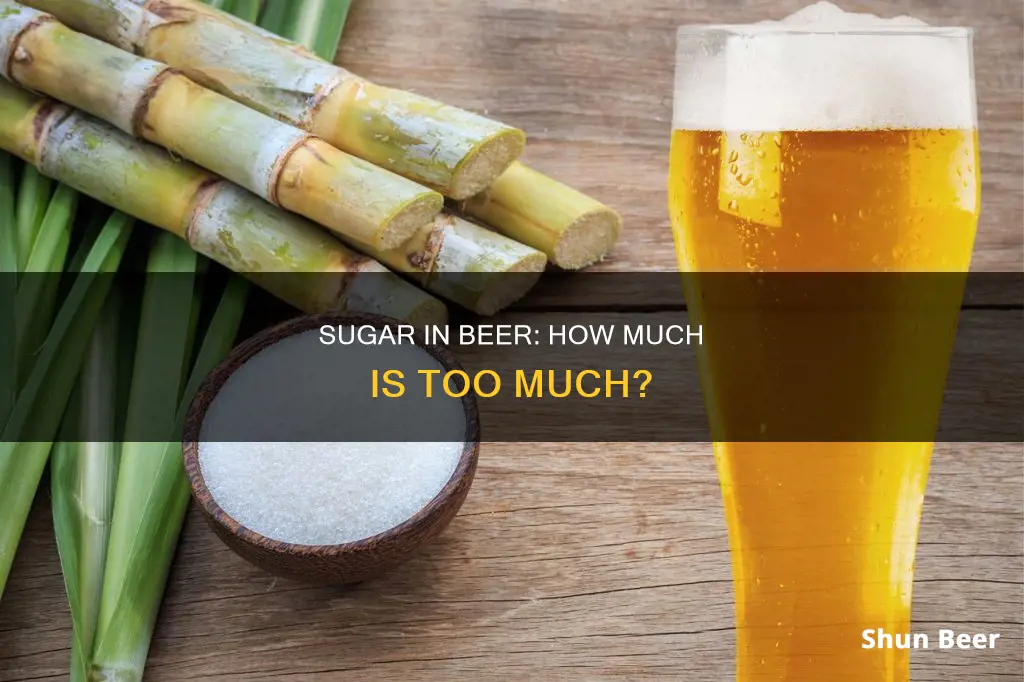
Beer is generally made from grains, spices, yeast, and water. While sugar is not added to the list of ingredients, it is necessary to produce alcohol. The amount of sugar in beer depends on the type of beer and the brewing process. The sugar content in beer comes from the grains and, in some cases, from additional ingredients such as honey and corn syrup. The amount of sugar in beer can vary from 0 grams to 15 grams per 12-ounce serving, depending on the type of beer and the brewing process. For example, light beers typically have less than 1 gram of sugar per 12-ounce serving, while non-alcoholic beers can have up to 15 grams of sugar per 12-ounce serving.
What You'll Learn

Beer's sugar content
Beers Sugar Content
The sugar content in beer varies depending on the type of beer, the ingredients used, and the brewing process. Beer typically contains very little sugar, with most beers having between 0 to 5 grams of sugar per 12-ounce serving. However, non-alcoholic beers can have significantly higher sugar content, ranging from 10 to 15 grams per 12-ounce serving.
Where Does Sugar in Beer Come From?
The sugar in beer comes primarily from the fermentation process, where yeast converts fermentable sugars from grains (usually barley or wheat) into alcohol and carbon dioxide. During the initial malting phase, grains are soaked, germinated, and dried to convert starches into fermentable sugars, mainly maltose.
Beer Gravity and Sugar Content
Beer gravity refers to the density of the wort (the sugar-containing liquid created during the brewing process) relative to water at various stages of fermentation. High gravity beers start with a wort that is rich in sugars, resulting in a beer with higher alcohol content and often a sweeter taste. In contrast, low gravity beers have less sugary wort, leading to lower alcohol content and residual sweetness.
Different Types of Beer and Their Sugar Content
The sugar content can vary widely across different types of beer. Regular beers typically contain moderate amounts of fermentable sugars, which are converted into alcohol during brewing. Light beers are designed to be lower in calories and sugar, with less than 1 gram of sugar per 12-ounce serving. IPAs also have low residual sugar levels, usually less than 1 gram per serving, due to the efficient fermentation process.
Health Considerations
While beer has a relatively low sugar content, it is important to consider its impact on blood sugar levels. Beer contains carbohydrates that can affect blood sugar levels, and alcohol can impair sugar metabolism, leading to potential hypoglycemia. Therefore, it is recommended to consume beer in moderation and with a carbohydrate-containing meal. Additionally, excessive consumption of beer can lead to weight gain and increase the risk of health issues such as heart disease and diabetes.
Sugar Secrets: Non-Alcoholic Beer's Sweet Surprise
You may want to see also

How sugar gets into beer
Beer is generally made from grains, yeast, spices, and water. Sugar is not usually added to the list of ingredients, but it is necessary to produce alcohol. So, how does sugar get into beer?
The brewing process consists of malting, mashing, boiling, fermenting, and maturation. In the malting stage, grains are soaked, germinated, and dried to convert stored starches into fermentable sugars. In the mashing stage, the malted grains are soaked in hot water to release these sugars, creating a sweet liquid called wort. During boiling, hops and other spices are added for flavour and to balance the sweetness with bitterness, and the wort is sterilised.
Once the wort is cooled, yeast is added during the fermentation stage. The yeast ferments the sugars, producing alcohol and carbon dioxide, and transforming the wort into beer. The final stage, maturation, is when the beer is stored and left to age, developing flavours and carbonation until it is ready to be served.
While most sugars are converted during fermentation, some residual sugar remains, contributing to the beer's taste and body. The amount of residual sugar depends on the type of beer. High gravity beers, for example, tend to have more residual sugars and stronger flavours.
Beer's main type of sugar is maltose, which is made from two glucose molecules. However, maltose and other simple sugars comprise only about 80% of the wort's fermentable sugar content. The remaining 20% consists of oligosaccharides, which the yeast does not ferment, and which also do not impact blood sugar levels.
Beer vs Soda: Which Has More Sugar?
You may want to see also

Types of sugar in beer
The most common type of sugar in beer is maltose, which is made from two glucose molecules. Maltose is produced when grains are mixed with hot water during the "mash" stage of brewing. The boiling water breaks down the grain and extracts its sugars.
However, there are dozens of other types of sugars that can be found in beer, depending on the grains used and any additional ingredients added for flavour. For example, honey, maple syrup, and molasses can be added to the brewing process and will contribute to the sugar content of the beer.
Beer contains two main types of sugar: simple sugars (such as glucose and fructose) and more complex sugars (such as oligosaccharides). Yeast ferments the simple sugars during fermentation, while some residual complex sugars remain, adding sweetness to the beer.
Draft Beer's Sugar Content: How Sweet is Too Sweet?
You may want to see also

Why sugar is a problem
Beer typically contains little sugar, but it does contain carbohydrates, which can raise your blood sugar levels. Sugar is an essential element in the beer-making process, but it is not added as an ingredient. Instead, it comes from the processing of grains and is then fermented by yeast to produce alcohol. While most sugars are converted into alcohol, the residual sugar that remains contributes to the beer's taste and body.
Now, here are the reasons why sugar is a problem:
Weight Gain and Obesity
Excessive sugar consumption has been linked to weight gain and obesity. Sugar-sweetened drinks, such as sodas, juices, and sweet teas, are loaded with fructose, a simple sugar that increases hunger and desire for food. Consuming fructose-rich beverages can lead to a higher intake of liquid calories, making it easy to gain weight. Obesity, in turn, is a significant risk factor for various health issues, including type 2 diabetes, heart disease, and certain types of cancer.
Increased Risk of Heart Disease
High-sugar diets have been associated with an increased risk of heart disease, the leading cause of death worldwide. Excessive sugar consumption can lead to obesity, inflammation, high triglycerides, high blood sugar, and high blood pressure, all of which are risk factors for cardiovascular problems. Additionally, consuming too much sugar, especially from sugar-sweetened drinks, has been linked to atherosclerosis, a disease characterized by fatty deposits that clog arteries.
Type 2 Diabetes
Diabetes is a leading cause of mortality and reduced life expectancy, and its prevalence has been increasing. While no direct causal link has been established, excessive sugar consumption has long been associated with an increased risk of type 2 diabetes. High sugar intake can contribute to weight gain and increased body fat, which are known risk factors for developing diabetes. Additionally, prolonged consumption of sugary foods and drinks can lead to insulin resistance, where the body's cells become less responsive to insulin, resulting in elevated blood sugar levels.
Increased Risk of Cancer
Consuming excessive amounts of sugar may increase the risk of certain types of cancer. High-sugar diets, particularly when coupled with obesity, can promote inflammation in the body and lead to insulin resistance, both of which are risk factors for cancer. Research has found a positive association between high sugar intake and an increased risk of prostate cancer and esophageal cancer.
Dental Health Issues
Consuming too much sugar can have detrimental effects on dental health. Bacteria in the mouth feed on sugar and produce acid byproducts, which can cause tooth demineralization and lead to cavities. Regularly exposing teeth to sugary foods and drinks can increase the risk of dental caries and enamel erosion, resulting in oral health complications.
Mood and Mental Health Disorders
High sugar consumption has been linked to various
Sugar in Beer: Pint-Sized Sweetness Explored
You may want to see also

How beer impacts blood sugar
Beer generally has a low sugar content, with regular beers containing little to no sugar. However, its impact on blood sugar levels is more complex. While beer can lower blood sugar levels due to its alcohol content, it also contains carbohydrates that can raise blood sugar. This dual effect can be challenging for people with diabetes or pre-diabetes, who need to closely monitor their blood sugar levels.
The sugar content in beer varies depending on the type and brand. Regular beers typically have minimal sugar, as most of it is fermented. Light beers have slightly higher sugar content, with some containing around 1 gram per can. Non-alcoholic beers have the highest sugar content, as the sugars are not converted into alcohol. However, even the highest-sugar beers usually contain just 2-3 grams of sugar per can.
The sugar in beer comes from the fermentation process, where yeast converts fermentable sugars from grains, such as barley or wheat, into alcohol and carbon dioxide. This process significantly influences the final sugar content, with some sugars remaining as residual sugars that contribute to the beer's taste and body.
Beer's impact on blood sugar levels is twofold. On the one hand, alcohol impairs sugar metabolism by inhibiting the body's production and breakdown of stored sugar, leading to potential hypoglycemia. On the other hand, beer contains carbohydrates that can raise blood sugar. This dual effect can be challenging to manage for people with diabetes or pre-diabetes, who need to closely monitor their blood sugar levels.
Additionally, the immediate effect of drinking beer is an increase in blood sugar levels due to the carbohydrates. However, over a longer period, these levels will decrease as the body processes the alcohol. This can be tricky for those using insulin or other medications that lower blood sugar, and it is recommended to consume alcohol with a carb-containing meal to maintain balance.
In summary, while beer typically has a low sugar content, its impact on blood sugar levels is more complex due to the interplay between its alcohol and carbohydrate content. For individuals monitoring their blood sugar, it is important to consume beer in moderation and be mindful of its potential effects on blood sugar levels.
Beer and Blood Sugar: A Dangerous Mix?
You may want to see also
Frequently asked questions
The amount of sugar in beer depends on the type of beer. Light beers usually have less than 1 gram of sugar per 12 oz serving, while non-alcoholic beers can have 10-15 grams of sugar per 12 oz serving. Regular beers and IPAs typically have low residual sugar levels, often less than 1 gram per serving.
Yes, the type of beer does matter when it comes to sugar content. Different beer styles, including ales, lagers, and stouts, exhibit distinct sugar profiles due to variations in yeast activity, brewing temperatures, and ingredients used.
The sugars in beer mostly originate from the brewing process itself. During the malting process, grains (typically barley) are soaked in hot water to start the germination process, which converts starches in the grains into simple, fermentable sugars.







